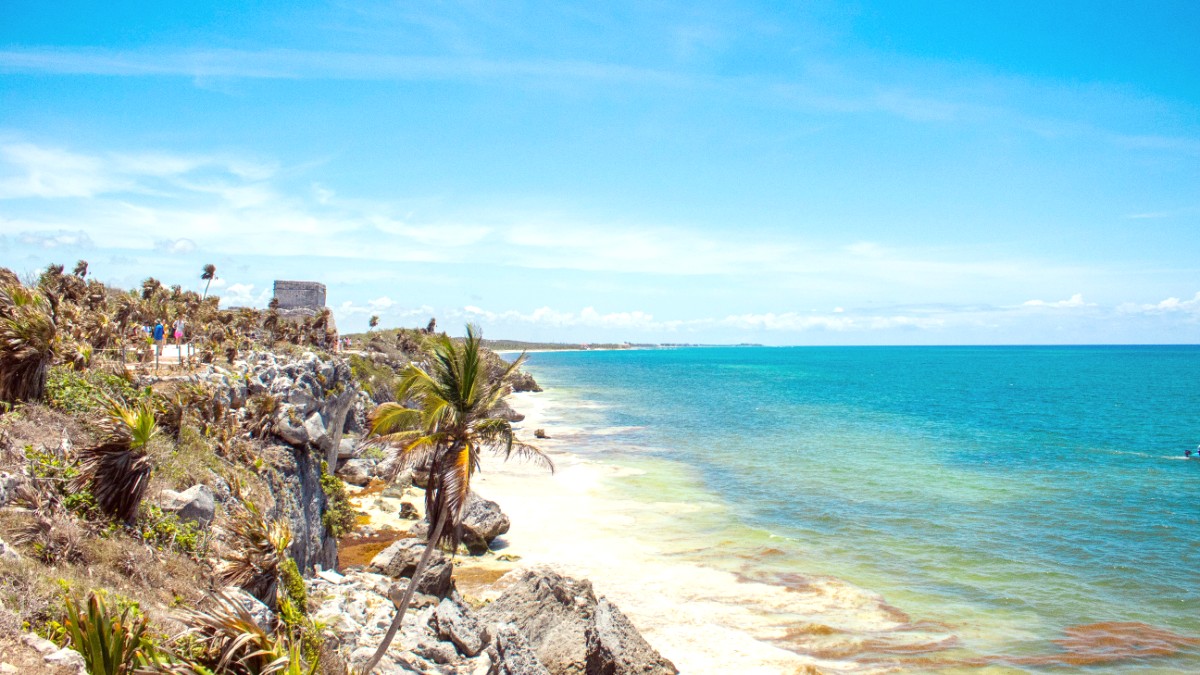
Yucatan Peninsula, Mexico
Tulum experiences a tropical climate, with two main seasons: dry and rainy.
Dry Season (November to April): This period brings warm temperatures and lower humidity. Average temperatures stay between 75°F and 85°F (24°C to 29°C). Minimal precipitation and abundant sunshine. Days are typically clear and bright, making excellent conditions for outdoor activities and beach relaxation. Evenings are cooler, especially in December and January, sometimes dipping into the low 70s°F (low 20s°C), making a light sweater or long-sleeved shirt a good item to pack.
Tulum sees distinct high, shoulder, and low seasons, each with its own advantages and challenges.
High Season (Late November/December to April): The weather is at its best, with lower humidity and less rain. Conditions are comfortable for exploring ruins, swimming in cenotes, and enjoying beaches. This period sees popular holiday travel times. Expect higher prices for accommodations, flights, and tours. Attractions will draw more visitors. Booking well in advance helps.
Late Nov/Dec - April
Best weather, lower humidity, comfortable for activities.
Higher prices, more crowded, advance booking needed.
May-July, November
Fewer crowds, better lodging/flight prices, warm ocean.
Humidity starts rising, brief rain showers, early hurricane season risk (June).
August - October
Lowest prices, dramatically fewer tourists, lush green landscape.
Peak hurricane season, highest humidity, some businesses may close, sargassum (seaweed) on beaches.
Officially runs from June 1 to November 30. The highest risk appears typically from August through October. While direct hurricane hits on Tulum are not common, tropical storms bring heavy rain, strong winds, and cause travel disruptions. Travelers visiting during this period check weather forecasts closely and consider purchasing comprehensive travel insurance.
Tulum stays warm throughout the year. While temperatures are comfortable in the dry season, the combination of high temperatures and humidity in the rainy season makes it feel much hotter. Heat advisories are uncommon, but constant Sun protection and hydration remain helpful.
November to April conditions; May to July warmer water with fewer crowds.
Visit early mornings during the dry season (November to April) to avoid intense heat and crowds.
Dry season underwater visibility, waters stay warm and suitable year-round.
A significant environmental issue, especially from April to October. It impacts beach aesthetics and swimming conditions.
Uncommon, but hydrate well and seek shade during peak sun hours.
Requirements may change by nationality. Check official sources before travel.
Many nationalities do not need a visa for tourist stays up to 180 days. A valid passport is a must.
Have these documents ready for immigration procedures.
Tulum presents a range of experiences, from budget-friendly adventures to luxury getaways. These estimates provide a general idea; actual costs vary.
Entrance fees vary by attraction, with cenotes showing a wide range.
Travel health clinic consultation is advisable before your trip.
Traveler's Diarrhea: A common issue. Prevent by drinking only bottled or purified water, avoiding ice in drinks unless purified, eating well-cooked food, and avoiding unpeeled fruits or raw vegetables washed in tap water. Carry Anti-diarrheal medication.
Mosquito-borne illnesses: Dengue, Chikungunya, and Zika exist in the region. Protect yourself by using Insect repellent with DEET or picaridin. Wear long sleeves and pants, especially at dawn and dusk.
Tulum has private clinics and smaller hospitals. For serious emergencies, larger and better-equipped hospitals are in Playa del Carmen (about an hour north) or Cancún (about two hours north).
Pharmacies are common; some medications available over-the-counter.
Dial 911 for all emergencies (police, fire, ambulance).
Tap water in Tulum is not for drinking. Always drink bottled or purified water. Most hotels and restaurants provide purified water for refilling.
Choose restaurants with good reviews and visible hygiene practices.
Avoid raw or undercooked seafood/meats from questionable sources. Be cautious with fresh salads.
Tulum is generally safe for tourists, specifically in tourist zones (Tulum Ruins, Hotel Zone, Cenotes). Petty crime (pickpocketing, bag snatching) occurs in crowded areas.
Stay aware of your surroundings; confirm prices before accepting services.
Isolated incidents of violence relate to organized crime. These typically do not target tourists but have indirect risks.
| Resource | Details | Affiliate Link |
|---|---|---|
| Travel Insurance | Highly recommended for medical emergencies, evacuation, trip cancellation. | World Nomads, SafetyWing, Insubuy |
| Flight Compensation | Compensation for delayed or canceled flights. | AirHelp |
| Anti-Theft Products | Bags and security items for valuables. | Pacsafe |
Tulum offers many price points. Be sure to budget accordingly.
$20 - $40 USD/night
$50 - $100 USD/night
$100 - $300 USD/night
Example Meal Prices
Street Food (tacos, empanadas): $1 - $3 USD per item
Local Eatery (comida corrida): $5 - $10 USD per meal
Mid-range Restaurant: $15 - $30 USD per person (without drinks)
Official currency is the Mexican Peso (MXN).
Rates fluctuate daily. Check reputable sources.
Widely available. Use those inside banks. Beware of fees.
Be aware of potential natural hazards during specific seasons.
Tulum is generally safe, but awareness helps prevent issues.
Petty crime happens in crowded areas. Stay aware of your surroundings.
Very safe, often with private security. Poor lighting on beach road at night.
Safe in main commercial areas. Be aware in less-trafficked side streets at night.